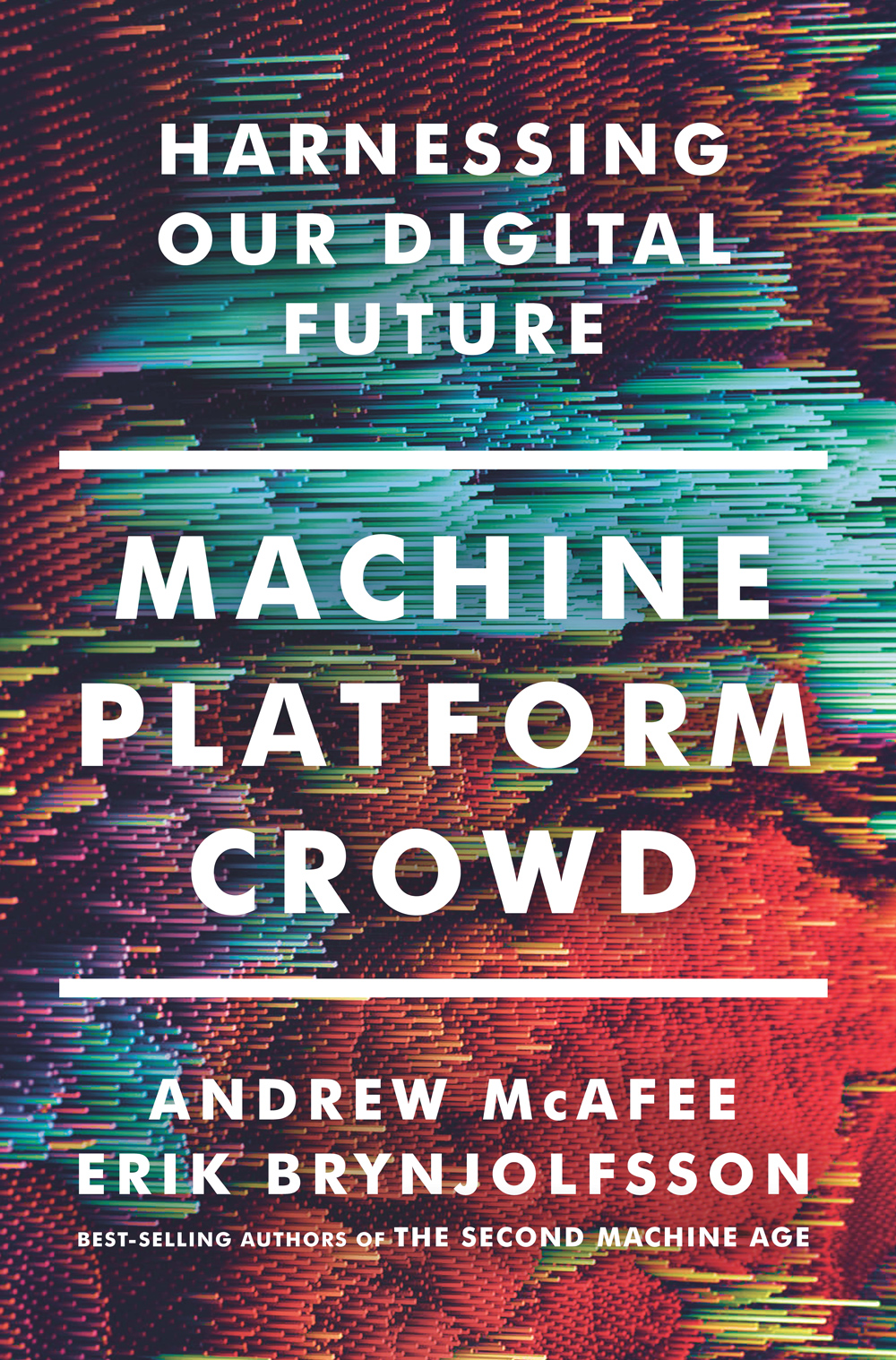
Andrew McAfee and Erik Brynjolfsson’s best-selling 2014 book, The Second Machine Age, explores how digital technology is transforming, and in many ways upending, our economy and our lives. Readers’ strong reactions to that book started the two cofounders of MIT’s Initiative on the Digital Economy (IDE) on the path toward their latest collaboration, Machine, Platform, Crowd: Harnessing Our Digital Future.
Brynjolfsson, IDE’s director and a Sloan professor, says they heard from fans of the previous book, “You made your case; we believe you. Now what do we do?” He adds, “We felt a responsibility to try to answer that question.”
In Machine, Platform, Crowd, he and McAfee, IDE’s co-director and a principal research scientist at Sloan, examine three trends changing business. First, they look at how our minds and ever-improving machines might work together to alter business processes. Second, they address the shifting relationship between products and the platforms consumers use to access them (paying particular attention to companies with few physical assets, such as Airbnb, a rental company that owns no properties, and Uber, a ride service that owns no cars). The third section explores how a company accustomed to relying on its own core processes and expertise can benefit from the knowledge of the crowd (as when GE launched an online campaign to solicit ideas for an innovative ice machine, getting valuable marketing data in the process).
The authors include questions designed to spur discussion and, they hope, action among organization leaders. “It’s not a cookbook, and it’s not step-by-step instructions,” says Brynjolfsson. “It provides the frameworks and intellectual understanding of how these factors relate together so that people can make intelligent decisions on their own.” He says this approach is especially relevant at a time of rapid change: “Part of what drove us was that we see so many things happening not just in terms of technology but also in terms of business models, but they are kind of chaotic. How do you make sense of these billion-dollar companies coming out of nowhere, and other billion-dollar companies going out of business, and people giving away products for free and becoming very wealthy, and other people struggling to find work?” While it can seem that there’s no rhyme or reason to what’s going on, he says that “if you have the right frameworks, a lot of this just makes a lot of sense.”
The coauthors’ collaboration is “incredibly smooth,” says McAfee—“We usually finish each other’s sentences”—but they also find that their occasional intellectual disagreements strengthen their work. When their points of view differ, “we spend some time hashing it out and trying to convince each other,” Brynjolfsson says. That process often leads them both to a third position.
Says McAfee: “When we think about something differently, that’s when things get really interesting.”
Recent Books
From the MIT Community
Machine, Platform, Crowd: Harnessing Our Digital Future
By Andrew McAfee ’88, SM ’90, and Erik Brynjolfsson, PhD ’91
W.W. Norton, 2017, $28.95
Robot Proof: Higher Education in the Age of Artificial Intelligence
By Joseph E. Aoun, PhD ’82
MIT Press, 2017, $24.95
Rebel Power: Why National Movements Compete, Fight, and Win
By Peter Krause, PhD ’11
Cornell University Press, 2017, $24.95
Process Safety: Key Concepts and Practical Approaches
By James A. Klein ’80 and Bruce K. Vaughen
CRC Press, 2017, $159.95
The “Peak Oil” Scare and the Coming Oil Flood
By Michael C. Lynch ’79, SM ’79
Praeger, 2016, $48
Finding Purpose: Environmental Stewardship as a Personal Calling
By Andrew J. Hoffman, SM ’91, PhD ’95
Greenleaf Publishing, 2016, $26.95
Working on the Dark Side of the Moon: Life Inside the National Security Agency
By Thomas Reed Willemain,
SM ’70, PhD ’72
Mill City Press, 2017, $15.99
Urban Planning’s Philosophical Entanglement: The Rugged, Dialectical Path from Knowledge to Action
By Richard S. Bolan, MCP ’56
Routledge, 2017, $149.95
Frankenstein: Annotated for Scientists, Engineers, and Creators of All Kinds
By Mary Shelley
Edited by David H. Guston, PhD ’93, Ed Finn, and Jason Scott Robert
MIT Press, 2017, $19.95
Please submit titles of books and papers published in 2016 and 2017 to be considered for this column.
Contact MIT News
E-mail mitnews@technologyreview.com
Write MIT News, One Main Street, 13th Floor, Cambridge, MA 02142
Keep Reading
Most Popular
Large language models can do jaw-dropping things. But nobody knows exactly why.
And that's a problem. Figuring it out is one of the biggest scientific puzzles of our time and a crucial step towards controlling more powerful future models.
The problem with plug-in hybrids? Their drivers.
Plug-in hybrids are often sold as a transition to EVs, but new data from Europe shows we’re still underestimating the emissions they produce.
Google DeepMind’s new generative model makes Super Mario–like games from scratch
Genie learns how to control games by watching hours and hours of video. It could help train next-gen robots too.
How scientists traced a mysterious covid case back to six toilets
When wastewater surveillance turns into a hunt for a single infected individual, the ethics get tricky.
Stay connected
Get the latest updates from
MIT Technology Review
Discover special offers, top stories, upcoming events, and more.